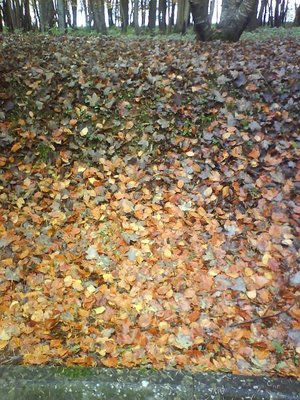autumn colours

I hope you're not yet sick of sycamores!
Previous posts have spoken about the wind-shrivelled look of sycamore leaves. It's a sort of no-colour fawn. It tends to be pale because the leaf curls inward, exposing the underside of the leaf.
But in wet conditions something different happens to the sycamore leaves; they fall without shrivelling, and may then develop into amazingly varied maps of colour while lying on the forest floor.
Like this:

A leaf like this is so eyecatching that you naturally assume it has a meaning, that it intends to be seen. Every autumn I wonder about this. We are told that the autumn colours of trees are an accidental residue, that they come into existence as the useful portions of green chlorophyll are reabsorbed into the tree's metabolism prior to the leaf's abscission. What's left is toxins and other things the tree doesn't wish to hang on to. They turn out to be - spectacular.
That seems odd to me. When we notice other brightly coloured things in nature, we can often grasp that this high visual impact has a function that involves it being noticed: flowers attracting bees, ripe berries attracting birds, male birds attracting mates, flash coloration (shocking a predator), warning coloration (deterring a predator), the gaping mouths of baby chicks (reminding a parent to feed them).
In Walter de la Mare's Desert Islands (1930) he refers to the wonder-arousing discoveries of science and (as an example) to an oak tree whose sensitivity to colour exceeds our own. Unfortunately, though he annotates almost everything else he forgets to do it here, so I don't know where he got this idea. But it may be true. Long after his book was written, plant photoreceptors have become a booming area of research. Light being such a critical substance for plants - it more or less equates to food - it perhaps shouldn't be surprising that they observe it very closely indeed. What they are doing is registering different light wavelengths, they are not seeing things with the help of light - what they have is not eyes with focussing lenses (if your tree has eyes, it's an Ent) but photoreceptors. Lots of different kinds. To get a flavour of recent research try this: Blue Light Signaling through the Cryptochromes and Phototropins. So That's What the Blues is All About by Liscum Hodgson and Campbell,Plant Physiology Dec 2003.
A tree could not see the details of this leaf-map, but it could in a general way detect the dramatically changed colour of the woodland floor. Or, since in this case the colours seem to emerge mainly after leaf-fall, could they have a function for the ground-fungi themselves?
But still, we have to admit that if vivid colour is often a signal, still there are many more visually striking things in nature that have no communicative intention at all. For example, a sunset. Though it seems to me the visual that just happens has a perceptibly different character from the one that some organism puts forth with communicative purpose.
Autumn is a time of year when the tumultuous, complex, power-struggling and rank order of plant growth is replaced by a different kind of order, impersonal and inorganic. This sculpture is often very striking, yet no living creature intends it. Look at these fallen larch-needles on tarmac:

If this is a message, it can only come from God. What I find particularly striking about this lovely script is that it would not be visible without the display-screen that we humans have inadvertently created; in this case, the surface of a car-park. This is analogous to frost-patterns on a window-pane and to the variety of weather-graphics that car-windows register on a rainy day. Even unintentionally, human artefacts prove to be resonators.
The swathes of organic matter that plants relinquish become matter for sculpture. Autumn is a winnower, a swirler of patterns, a clarifier, a cleaner, a grader. A healthy recycling facility should always make such patterns, too.

Labels: Plants


3 Comments:
Thanks for these reflections! I am wondering if the solution to the mystery is at the other end. Rather than wonder what benefit to the tree arises from its autumn coloration, particularly those leaves which have already fallen from the parent, we might speculate why we as the human species find the colours beautiful. Perhaps it is to our evolutionary advantage and not the tree's?
I asked a related question about coloration and evolution in this post on my own blog, on chestnut blossoms. Do you have any thoughts on it?
Well I'll certainly be watching out for those horsechestnut blossoms next May! The explanation that you've quoted though surely on the right general lines seems incomplete, as it neither mentions nor explains the vivid magenta (a colour bees are normally very fond of).
You may be right about the human species & autumn leaves - . Certainly none of my proposals seems at all promising!
Isn't there also a sense of, Don't eat this, it's rotting?
Post a Comment
<< Home